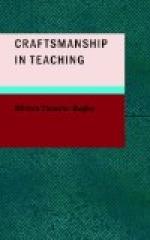Of the use to which reading circles may be put in improving the efficiency of teaching, it is necessary to say but little. Such organizations, under wise leadership, may doubtless be made to serve a good purpose in promoting professional enthusiasm. The difficulty with using them to promote immediate and direct efficiency lies in the paucity of the literature that is at our disposal. Most of our present-day works upon education are very general in their nature. They are not without their value, but this value is general and indirect rather than immediate and specific. A book like Miss Winterburn’s Methods of Teaching, or Chubb’s Teaching of English[8] is especially valuable for young teachers who are looking for first-hand helps. But books like this are all too rare in our literature.
On the whole, I think that the improvement of teachers in the matter of methods is the most unsatisfactory part of our problem.[9] All that one can say is that the work of the best teachers should be observed carefully and faithfully, that the methods upon which there is little or no dispute should be given and accepted as standard, but that one should be very careful about giving young teachers an idea that there is any single form under which all teaching can be subsumed. I know of no term that is more thoroughly a misnomer in our technical vocabulary than the term “general method.” I teach a subject that often goes by that name, but I always take care to explain that the name does not mean, in my class, what the words seem to signify. There are certain broad and general principles which describe very crudely and roughly and inadequately certain phases of certain processes that mind undergoes in organizing experience—perception, apperception, conception, induction, deduction, inference, generalization, and the like. But these terms have only a vague and general connotation; or, if their connotation is specific and definite, it has been made so by an artificial process of definition in which counsel is darkened by words without meaning.




